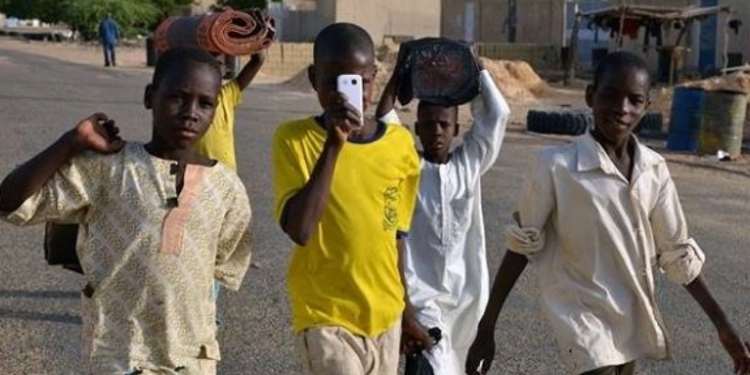- UNESCO says Nigeria’s out-of-school children hits 20 million
- Experts express concern over the attendant consequences
- FG says plans under way to ameliorate the situation
The Nigerian government, experts, international development partners and Non-governmental Organizations are currently at their wits end as to how to tackle the pervasive issue of out-of-school children in Nigeria.
The country is still struggling to find solutions to the menace amidst the damning records of UNESCO findings on the number of out of school children in Nigeria.
Not withstanding the dedicated campaigns, collaboration between stakeholders and other national and international efforts geared towards remedying the ugly trend, the number of out-of-school children continues to be a persistent challenge to Nigeria.
According to the United Nations Educational, Scientific and Cultural Organisation (UNESCO) the total number of out-of-school children (OSC) in Nigeria is more than 20 million.
However, the Universal Basic Education Commission (UBEC) states that it is slightly above 10 million.
Explaining further, UNESCO stated that the data is based on those aged six to 18 years, ranging from primary one to senior secondary school three, while UBEC’s figure is related to those aged six to 11.
In any case, from whatever numbers one looks at it, the reality remains that Nigeria currently holds a record as one of the highest number of out-of-school children in the world.
According to the 2022 UNESCO report, approximately 20 million Nigerian individuals of its approximately 200 million population are not enrolled in school.

Needless to stress that this amounts to 10 percent of Nigeria’s entire population and is more than the overall population of various countries in African continent.
The report further gave insight to the fact that there are 244 million children and youth between the ages of six and 18 worldwide who are still out of school and “the region with the second highest out-of-school population is Central and Southern Asia with 85 million.”
The report further narrated that the top three countries with the most children and youth excluded from education included India, Nigeria and Pakistan.
Nevertheless, the Federal Ministry of Education in response tagged, “UNESCO Global Education Monitoring Report 2022 and the Phenomenon of Out-Of-School Children in Nigeria,” wrote that “though UIS has attempted to justify the methods used in arriving at the 20 million figure, the fact remains that this report is capable of misinforming the public, misrepresenting the actual situation of the out-of-school children in Nigeria and underrating the significant efforts made by the government in addressing the OOSC challenge.”
The report further accused the states governments for resto g on their oars, thereby escalating the situation.
It further states that it’s the responsibility of states and local governments to provide primary and secondary education in Nigeria.
It also stressed that the federal government has been working closely in partnership to develop the sub-sector generally and address the OOSC challenge.
“The federal government provides financial and technical assistance to the states and local governments as part of its intervention in the delivery of Universal Basic Education (UBE) which covers primary and junior secondary,” the report said.
The report showed that the 2018 Nigerian Publishers Association (NPA) study established the number of OOSC, age six – 11 (Primary School-going age), at 10.193,918, regionally distributed as follows: North Central: 1,329,111, North East: 2,0012,038, North West: 3,490,671, South East: 713,176, South South: 1,208,1832 and South West: 1,451,740. Similarly, the figure of 6,192,081 was established for age 12– 14 for Junior Secondary School going age. “The 2018 NPA took cognizance of Nigeria’s designated age bracket for universal basic education (primary and junior secondary, age six – 14) and did not extend to the senior secondary cadre (age 15 – 17) and the post-secondary school age of 18, which are both part of the UNESCO’s 20 million figure.”
Causes of out-of-school children
It is very imperative to examine the likely causes of the escalating number of out-of-school children in the country with a view to knowing how we can tackle the situation.
Insecurity in many states
A closer look at the 2022 UNESCO records shows that North West and North East have the highest number of out-of-school children in the country.
This also is a backlash from the soaring cases of insecurity in the region.
For over a decade now, there has been insurgency in the zones. From the Boko Haram insurrection to banditry, the two regions have known no peace for more than a decade now. This contributed immensely in the number of out-of-school children in the zone.
Harsh economy situation
Like a vicious cycle, harsh portends out-of-school children which in turns gives birth to insecurity and the cycle continues.
In any case, recently, the National Economic Summit Group, NESG, issued a statement, saying that out of the 130 million Nigerians wallowing in multidimensional poverty, 80million are children.
NESG’s Chief Executive Officer designate, Dr. Tayo Aduloju, made this statement on the sideline of the just concluded 29th edition of the Nigerian Economic Summit, NES#29, in Abuja.
According to Dr. Aduloju “Some children are left in Multidimensional poverty and over 20million out of school. If we continue to leave that population in that situation, it means we are leaving children well being and have left them unprepared for the future.”
With this report, Nigeria needs no soothsayer to predict that 2023 UNESCO report on out-of-school children will even be worse. In many families in Nigeria, it is an uphill task to eat even once a day, talk more of sending their children to school. It is that bad that even in many government schools where no tuition fees is paid, it is still very difficult for these parents to provide basic education materials like textbooks, exercise books, school bags, school uniforms for their children and wards.
Since the removal of fuel subsidy in Nigeria in May 2023, many families are finding it extremely difficult to send their children and wards to school as most of live where transportation is out of reach.
High rate of unemployment
According to National Bureau of Statistics, the unemployment rate in Nigeria currently stands at 5.3%. The soaring rate of unemployment in the country is also not left out in the current cause of growing number of out-of-school children in the country.

In a country where graduates cannot find their footing as far as gainful employment is concerned, it is always convince younger ones on the need to attend school.
In a country where its leaders have questionable academic records, yet they are not much bordered about it, it remains an uphill task to convince the younger ones on the need for academic achievement.
FG interventions on out-of-school children
It is on record that to increase equitable access for out-of-school children, improve literacy and strengthen accountability at the basic education level, the Federal government committed a N220 billion credit facility from the World Bank to the Better Education Service Delivery for All (BEDSA) in 17 states of the federation.
Again 2020, the UBEC introduced the Open School Programme (OSP). Piloted in six states, it was designed to reduce the country’s out-of-school children burden.
More so, the Nigeria’s School Feeding Programme, started in 2016, was designed to improve child nutrition and increase school enrollment.
However, most of these interventions have yet to work out.
Not withstanding these programmes and strategies deployed by the federal government to cut down the number of out-of-school children, the number has continued to increase quite astronomically.
With the Nigeria’s free basic education, it has been discovered that its budgetary spending on education is notoriously low thereby leading to poor basic education outcomes.
In fact, the World Bank has said that Nigeria is currently experiencing learning poverty with up to 70% of 10-year-olds who cannot perform basic numeracy tasks.
With sad reality of poor financing, government schools are dilapidated and lack fundamental education infrastructures like classrooms.
Not able to stomach this ugly situation so many parents often have to pay for furniture, school materials, etc. Private school education is not an option for Nigeria’s poor parents and guardians.
Findings have shown that “free” education in Nigeria costs more than tuition and free lunch, and this may be why the many interventions are yet to yield results.




Discussion about this post